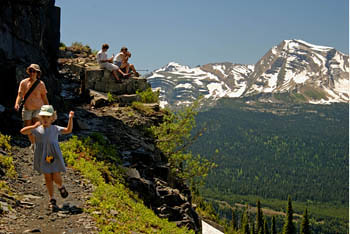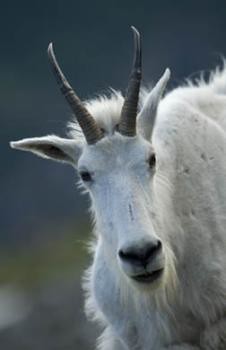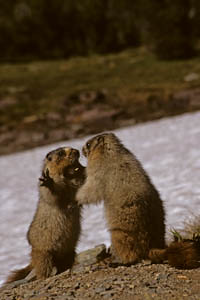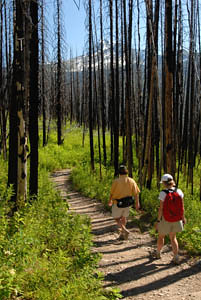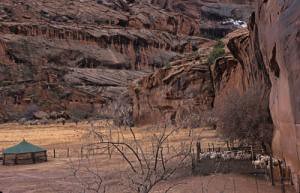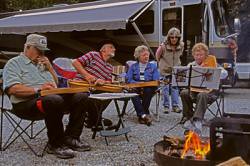MANY STORIED SANDS
posted: March 11th, 2008 | by:Bert
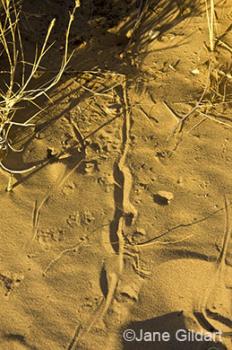
Kangaroo rat tracks
©Jane Gildart: Camping at Kelso Dunes in Mojave National Preserve is a delight. Three miles off the beaten road, there are no amenities, not even water. Just sand–an endless expanse of it. In other words, those who intend to stay need to plan!
But, the rewards are silence; desert flowers popping up everywhere; stars creating a heavenly smorgasbord of patterns; and the ever-changing light playing on the dunes. And, of course, there are the stories created by all the creatures that live in these 45-square miles of sand.
THE MORNING HERALD
Yesterday and last night a strong wind blew constantly. I woke early this morning, knowing that the lower sand dunes would be fresh, obliterating all old tracks of humans and mammals. It is kind of like looking at fresh snow before anyone else gets to see what’s there.
I knew that kangaroo rats (they hop) live here, as do coyotes and kit fox (the tiny fox with the large ears). Before long I spotted the trails of two kit foxes (maybe this is their idea of a date), going after a kangaroo rat. At one point I could see where the fox might have come to an abrupt stop, maybe playing with the rat.
The rat’s tail left a foot-long line in the sand near its hole, but it was hard to determine if the rat had escaped or had been grabbed by the pursuing kit fox.
Whatever, the fox had trotted off into the cactus area. Because kangaroo rats are so interesting, I wasn’t rooting for either. Simply said, it is all part of nature.
FLOWERS NOW EMERGING
If coyotes had been there in the night, we’d have heard their “singing dog” sounds, and maybe seen their tracks too. Kit fox tracks are smaller than those made by coyotes and all was silent in the desert except for the songs created by the wind.

Wild rhubarb
It was fun to see what each mound of sand had to offer not only in the way of new tracks, but also in the way of all the now-emerging spring flowers.
But for awhile, it was all the tales the mammals had left during the night that so thoroughly held my attention-in these many-storied sands.
Read Comments | Comments Off
 Janie Gildart: Several days ago, the Luhrs (our Airstream friends) packed up from Bay Bayou RV Resort to continue their travel odyssey. But before leaving the Tampa area, they invited us to spend one last nostalgic evening with them as they camped at the Skyway Fishing Pier State Park, which parallels the Sunshine Skyway Bridge.
Janie Gildart: Several days ago, the Luhrs (our Airstream friends) packed up from Bay Bayou RV Resort to continue their travel odyssey. But before leaving the Tampa area, they invited us to spend one last nostalgic evening with them as they camped at the Skyway Fishing Pier State Park, which parallels the Sunshine Skyway Bridge. Unfortunately, the new bridge also has a tragic attraction. As with many other bridges and high places, the top of this bridge draws those attempting suicide and the sad statistics continue to rise. So much so that authorities are trying to implement the use of suicide-prevention techniques. Enough sad news…
Unfortunately, the new bridge also has a tragic attraction. As with many other bridges and high places, the top of this bridge draws those attempting suicide and the sad statistics continue to rise. So much so that authorities are trying to implement the use of suicide-prevention techniques. Enough sad news… As evening closed in and the pink sky grew black, we saw a manta ray swim by, followed by what appeared to be a huge crab migration. Where they were going and what kind of crabs they were remains a mystery.
As evening closed in and the pink sky grew black, we saw a manta ray swim by, followed by what appeared to be a huge crab migration. Where they were going and what kind of crabs they were remains a mystery. Janie Gildart: Welcome to Tarpon Springs, FL
Janie Gildart: Welcome to Tarpon Springs, FL Harvesting this primitive marine animal is quite a job. The sponge boats travel about eight miles out into the Gulf of Mexico where divers then spend hours selecting the proper sponges to be cut. No sponge smaller than five inches in diameter or height can be taken.
Harvesting this primitive marine animal is quite a job. The sponge boats travel about eight miles out into the Gulf of Mexico where divers then spend hours selecting the proper sponges to be cut. No sponge smaller than five inches in diameter or height can be taken. After sponge browsing (and buying) it was off to the restaurant. We all chose something different—it was share time. Our selections included Saganaki, a flaming cheese appetizer (everyone must shout “Opa” as the waiter lights the cheese); calamari, gyros, dolmades, and on and on. Then…to the dessert! You know, the thing you gotta’ have lots of, then wonder why you did it.
After sponge browsing (and buying) it was off to the restaurant. We all chose something different—it was share time. Our selections included Saganaki, a flaming cheese appetizer (everyone must shout “Opa” as the waiter lights the cheese); calamari, gyros, dolmades, and on and on. Then…to the dessert! You know, the thing you gotta’ have lots of, then wonder why you did it.